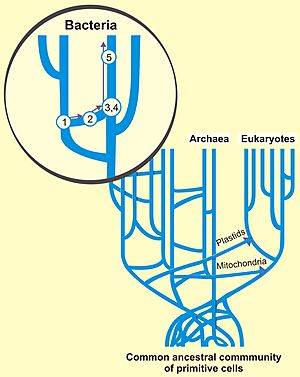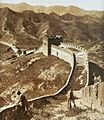Population genetics facts for kids
Population genetics is the branch of genetics which studies the genetic composition of populations. It brings together genetics, evolution, natural selection, breeding, statistics and mathematics. Mathematical and computer models are produced, and field research is done to test the models.
- "Population geneticists spend most of their time doing one of two things: describing the genetic structure of populations, or theorizing on the evolutionary forces acting on populations.
A brief history
Starting, perhaps, with G. Udny Yule's paper in 1902, population theorists tackled key issues in genetics and evolution. G.H. Hardy and Wilhelm Weinberg showed that if a population had random mating, no selection, migration or mutation, then the proportion of alleles would remain the same generation after generation. This was the Hardy–Weinberg law, the first great result of this new field of research.
Population genetics made great progress from 1918 to 1937. During this period, Ronald Fisher, J.B.S. Haldane and Sewall Wright worked on the connection between evolution and genetics, using new mathematical techniques, such as statistical probability. E.B. Ford and Theodosius Dobzhansky did field research on the genetics of natural populations of lepidoptera and Drosophila, respectively. Broadly speaking, this work proved that the newly rediscovered Mendelian genetics could be reconciled with Darwinian evolution. This laid the groundwork for the modern evolutionary synthesis, which took place in the following years, from about 1937 to 1953.
In the second half of the 20th century, population geneticists tackled a range of complex evolutionary problems, such as the kin selection (altruism), mimicry and molecular evolution. The key figures included John Maynard Smith, Motoo Kimura and William Hamilton. Techniques developed for population genetics help to decide what contribution heredity and environment make in developmental biology.
Images for kids
-
Gene flow is the transfer of alleles from one population to another population through immigration of individuals. In this example, one of the birds from population A immigrates to population B, which has fewer of the dominant alleles, and through mating incorporates its alleles into the other population.
-
The Great Wall of China is an obstacle to gene flow of some terrestrial species.
See also
 In Spanish: Genética de poblaciones para niños
In Spanish: Genética de poblaciones para niños





